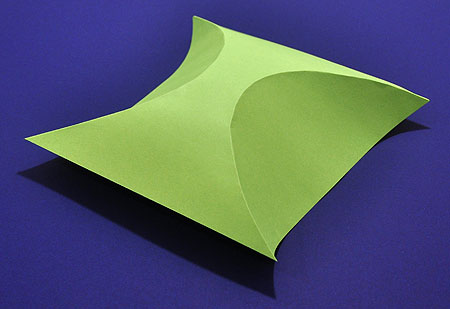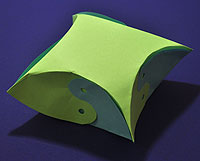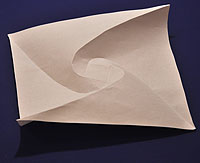Curved Folding

This elegant shape was formed by making two parabolic creases. That's it! The curved folds coax the piece of paper into a 3D shape.
Think about the 3D surfaces that you can make out of paper without folding. You can roll a sheet of paper into a cylinder and a cone, but try as you might, you cannot form a sphere without introducing all sorts of kinks, wrinkles, and puckers. The mathematical name for the types of shapes that you can make from paper are developable surfaces. A plane, cylinder, cone (both elliptical and circular) are examples of developable surfaces. The final developable surface is a tangent developable. To picture this type of surface think of a strip of paper that you put waves or twists into. Regular paper folding and curved folding create shapes built from developable surfaces.
Steps
- Score the crease line that is marked on the pattern and cut out the square.
- Pinch along the crease line.
Links
 The project above is only a hint at what is possible with curved folding. Curvedfolding.com has photos and crease patterns for many wonderful shapes including the one shown here. A pattern for it can be found on Philip Chapman-Bell's Flickr page.
The project above is only a hint at what is possible with curved folding. Curvedfolding.com has photos and crease patterns for many wonderful shapes including the one shown here. A pattern for it can be found on Philip Chapman-Bell's Flickr page. I tried to recreate this shape that Dr. David Huffman developed based on a brief write-up on his work that includes a photo. My pattern for this design is here: 8½" × 11" Pattern and A4 Pattern.
I tried to recreate this shape that Dr. David Huffman developed based on a brief write-up on his work that includes a photo. My pattern for this design is here: 8½" × 11" Pattern and A4 Pattern.- Erik Demaine has a history of curved folding on his website.
